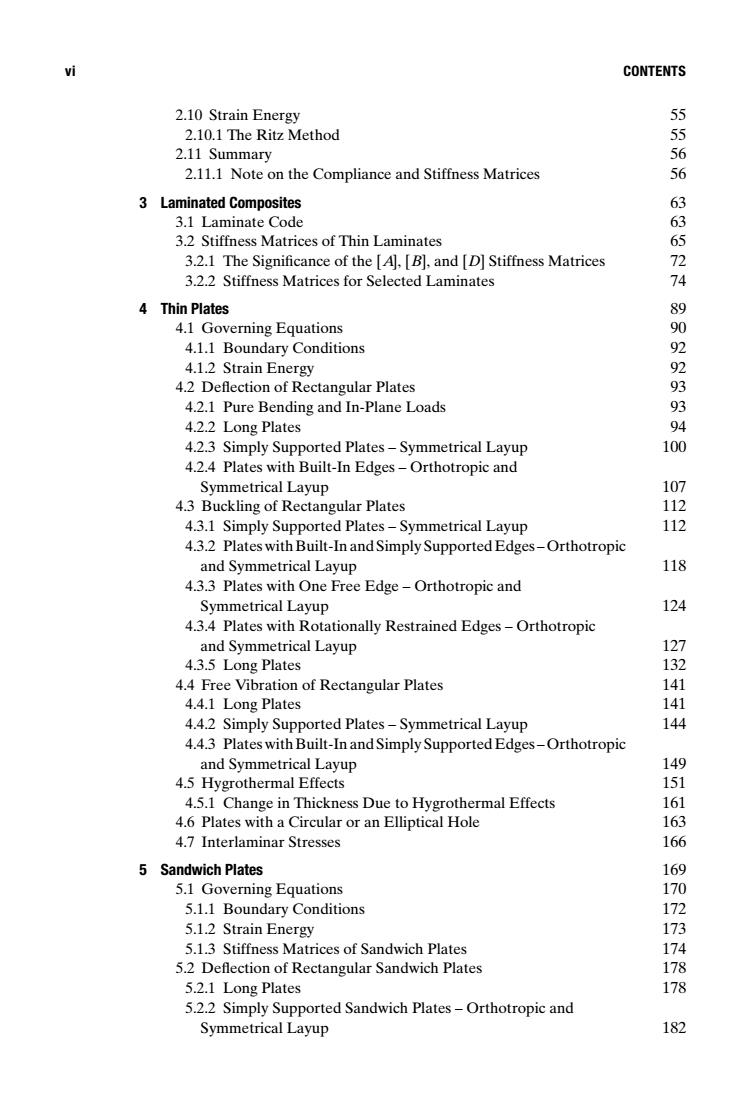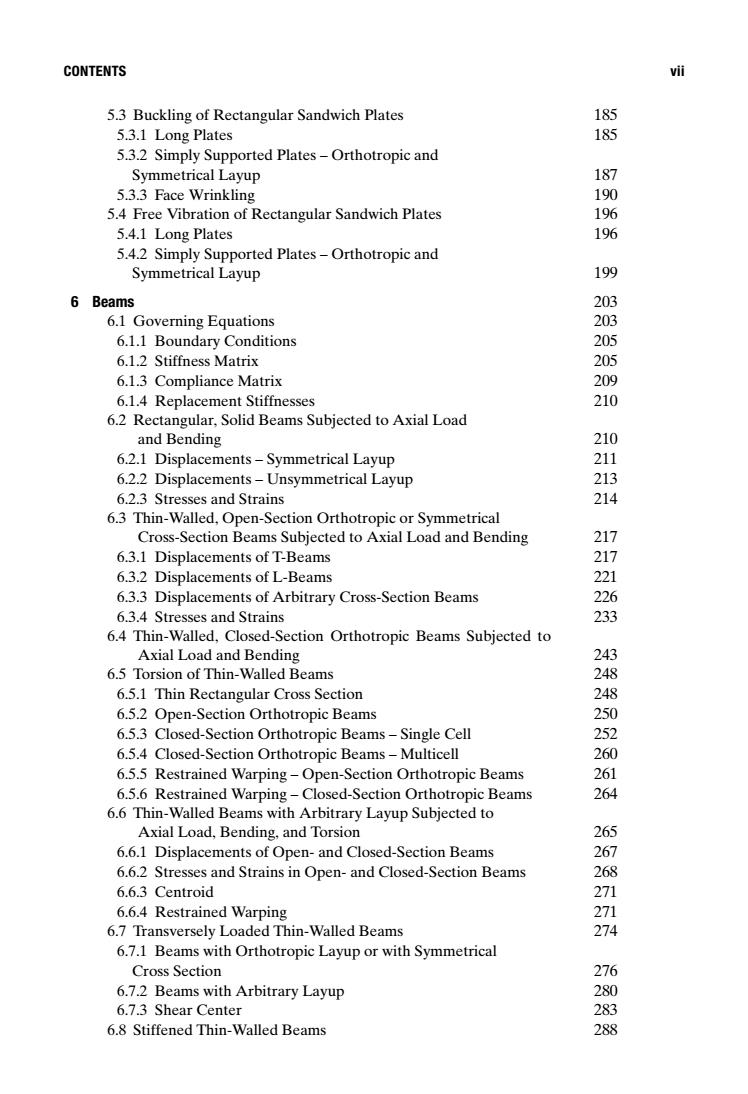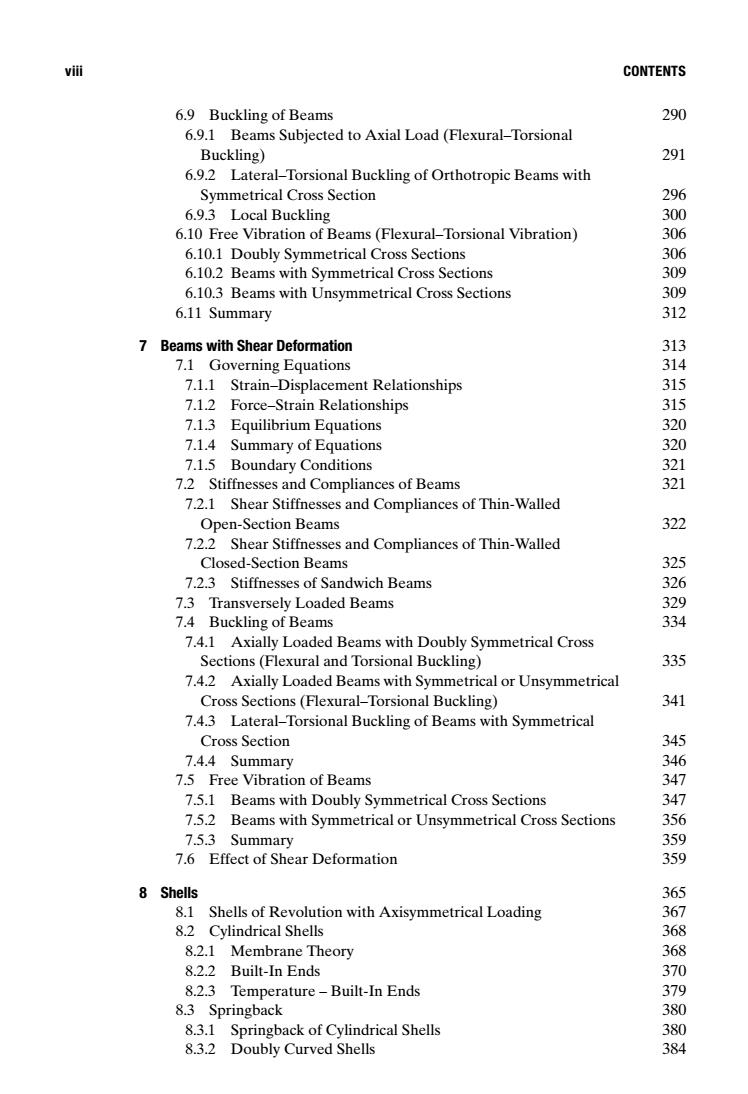
Copyrighted Materials Cogt620 Crp Ui奇ess fon www女aa Contents Preface page xi List of Symbols xiii 1 Introduction 义 2 Displacements,Strains,and Stresses 2.1 Strain-Displacement Relations × 2.2 Equilibrium Equations 6 2.3 Stress-Strain Relationships 8 2.3.1 Generally Anisotropic Material 8 2.3.2 Monoclinic Material 11 2.3.3 Orthotropic Material 14 2.3.4 Transversely Isotropic Material 19 2.3.5 Isotropic Material 20 2.4 Plane-Strain Condition 2.4.1 Free End-Generally Anisotropic Material 8 2.4.2 Free End-Monoclinic Material 2.4.3 Free End-Orthotropic,Transversely Isotropic, or Isotropic Material 4 2.4.4 Built-In Ends-Generally Anisotropic Material 3 2.4.5 Built-In Ends-Monoclinic Material 6 2.4.6 Built-In Ends-Orthotropic,Transversely Isotropic, or Isotropic Material 2.5 Plane-Stress Condition 38 2.6 Hygrothermal Strains and Stresses 2.6.1 Plane-Strain Condition 为 2.6.2 Plane-Stress Condition 2.7 Boundary Conditions 2.8 Continuity Conditions 2.9 Stress and Strain Transformations 2.9.1 Stress Transformation 2.9.2 Strain Transformation 7473890023 2.9.3 Transformation of the Stiffness and Compliance Matrices
Contents Preface page xi List of Symbols xiii 1 Introduction 1 2 Displacements, Strains, and Stresses 3 2.1 Strain–Displacement Relations 4 2.2 Equilibrium Equations 6 2.3 Stress-Strain Relationships 8 2.3.1 Generally Anisotropic Material 8 2.3.2 Monoclinic Material 11 2.3.3 Orthotropic Material 14 2.3.4 Transversely Isotropic Material 19 2.3.5 Isotropic Material 20 2.4 Plane–Strain Condition 22 2.4.1 Free End – Generally Anisotropic Material 28 2.4.2 Free End – Monoclinic Material 30 2.4.3 Free End – Orthotropic, Transversely Isotropic, or Isotropic Material 34 2.4.4 Built-In Ends – Generally Anisotropic Material 35 2.4.5 Built-In Ends – Monoclinic Material 36 2.4.6 Built-In Ends – Orthotropic, Transversely Isotropic, or Isotropic Material 38 2.5 Plane-Stress Condition 38 2.6 Hygrothermal Strains and Stresses 44 2.6.1 Plane-Strain Condition 47 2.6.2 Plane-Stress Condition 47 2.7 Boundary Conditions 47 2.8 Continuity Conditions 48 2.9 Stress and Strain Transformations 49 2.9.1 Stress Transformation 50 2.9.2 Strain Transformation 52 2.9.3 Transformation of the Stiffness and Compliance Matrices 53 v

vi CONTENTS 2.10 Strain Energy 55 2.10.1 The Ritz Method 5 2.11 Summary 56 2.11.1 Note on the Compliance and Stiffness Matrices 56 3 Laminated Composites 63 3.1 Laminate Code 63 3.2 Stiffness Matrices of Thin Laminates 65 3.2.1 The Significance of the [A],B],and [D]Stiffness Matrices 72 3.2.2 Stiffness Matrices for Selected Laminates 74 4 Thin Plates 89 4.1 Governing Equations 90 4.1.1 Boundary Conditions 92 4.1.2 Strain Energy 92 4.2 Deflection of Rectangular Plates 93 4.2.1 Pure Bending and In-Plane Loads 93 4.2.2 Long Plates 94 4.2.3 Simply Supported Plates-Symmetrical Layup 100 4.2.4 Plates with Built-In Edges-Orthotropic and Symmetrical Layup 107 4.3 Buckling of Rectangular Plates 112 4.3.1 Simply Supported Plates-Symmetrical Layup 112 4.3.2 Plates with Built-In and Simply Supported Edges-Orthotropic and Symmetrical Layup 118 4.3.3 Plates with One Free Edge-Orthotropic and Symmetrical Layup 124 4.3.4 Plates with Rotationally Restrained Edges-Orthotropic and Symmetrical Layup 127 4.3.5 Long Plates 132 4.4 Free Vibration of Rectangular Plates 141 4.4.1 Long Plates 141 4.4.2 Simply Supported Plates-Symmetrical Layup 144 4.4.3 Plates with Built-In and Simply Supported Edges-Orthotropic and Symmetrical Layup 149 4.5 Hygrothermal Effects 151 4.5.1 Change in Thickness Due to Hygrothermal Effects 161 4.6 Plates with a Circular or an Elliptical Hole 163 4.7 Interlaminar Stresses 166 5 Sandwich Plates 169 5.1 Governing Equations 170 5.1.1 Boundary Conditions 172 5.1.2 Strain Energy 173 5.1.3 Stiffness Matrices of Sandwich Plates 174 5.2 Deflection of Rectangular Sandwich Plates 178 5.2.1 Long Plates 178 5.2.2 Simply Supported Sandwich Plates-Orthotropic and Symmetrical Layup 182
vi CONTENTS 2.10 Strain Energy 55 2.10.1 The Ritz Method 55 2.11 Summary 56 2.11.1 Note on the Compliance and Stiffness Matrices 56 3 Laminated Composites 63 3.1 Laminate Code 63 3.2 Stiffness Matrices of Thin Laminates 65 3.2.1 The Significance of the [A], [B], and [D] Stiffness Matrices 72 3.2.2 Stiffness Matrices for Selected Laminates 74 4 Thin Plates 89 4.1 Governing Equations 90 4.1.1 Boundary Conditions 92 4.1.2 Strain Energy 92 4.2 Deflection of Rectangular Plates 93 4.2.1 Pure Bending and In-Plane Loads 93 4.2.2 Long Plates 94 4.2.3 Simply Supported Plates – Symmetrical Layup 100 4.2.4 Plates with Built-In Edges – Orthotropic and Symmetrical Layup 107 4.3 Buckling of Rectangular Plates 112 4.3.1 Simply Supported Plates – Symmetrical Layup 112 4.3.2 Plates with Built-In and Simply Supported Edges – Orthotropic and Symmetrical Layup 118 4.3.3 Plates with One Free Edge – Orthotropic and Symmetrical Layup 124 4.3.4 Plates with Rotationally Restrained Edges – Orthotropic and Symmetrical Layup 127 4.3.5 Long Plates 132 4.4 Free Vibration of Rectangular Plates 141 4.4.1 Long Plates 141 4.4.2 Simply Supported Plates – Symmetrical Layup 144 4.4.3 Plates with Built-In and Simply Supported Edges – Orthotropic and Symmetrical Layup 149 4.5 Hygrothermal Effects 151 4.5.1 Change in Thickness Due to Hygrothermal Effects 161 4.6 Plates with a Circular or an Elliptical Hole 163 4.7 Interlaminar Stresses 166 5 Sandwich Plates 169 5.1 Governing Equations 170 5.1.1 Boundary Conditions 172 5.1.2 Strain Energy 173 5.1.3 Stiffness Matrices of Sandwich Plates 174 5.2 Deflection of Rectangular Sandwich Plates 178 5.2.1 Long Plates 178 5.2.2 Simply Supported Sandwich Plates – Orthotropic and Symmetrical Layup 182

CONTENTS vii 5.3 Buckling of Rectangular Sandwich Plates 185 5.3.1 Long Plates 185 5.3.2 Simply Supported Plates-Orthotropic and Symmetrical Layup 187 5.3.3 Face Wrinkling 190 5.4 Free Vibration of Rectangular Sandwich Plates 196 5.4.1 Long Plates 196 5.4.2 Simply Supported Plates-Orthotropic and Symmetrical Layup 199 6 Beams 203 6.1 Governing Equations 203 6.1.1 Boundary Conditions 205 6.1.2 Stiffness Matrix 205 6.1.3 Compliance Matrix 209 6.1.4 Replacement Stiffnesses 210 6.2 Rectangular,Solid Beams Subjected to Axial Load and Bending 210 6.2.1 Displacements-Symmetrical Layup 211 6.2.2 Displacements-Unsymmetrical Layup 213 6.2.3 Stresses and Strains 214 6.3 Thin-Walled,Open-Section Orthotropic or Symmetrical Cross-Section Beams Subjected to Axial Load and Bending 217 6.3.1 Displacements of T-Beams 217 6.3.2 Displacements of L-Beams 221 6.3.3 Displacements of Arbitrary Cross-Section Beams 226 6.3.4 Stresses and Strains 233 6.4 Thin-Walled,Closed-Section Orthotropic Beams Subjected to Axial Load and Bending 243 6.5 Torsion of Thin-Walled Beams 248 6.5.1 Thin Rectangular Cross Section 248 6.5.2 Open-Section Orthotropic Beams 250 6.5.3 Closed-Section Orthotropic Beams-Single Cell 252 6.5.4 Closed-Section Orthotropic Beams-Multicell 260 6.5.5 Restrained Warping-Open-Section Orthotropic Beams 261 6.5.6 Restrained Warping-Closed-Section Orthotropic Beams 264 6.6 Thin-Walled Beams with Arbitrary Layup Subjected to Axial Load,Bending,and Torsion 265 6.6.1 Displacements of Open-and Closed-Section Beams 267 6.6.2 Stresses and Strains in Open-and Closed-Section Beams 268 6.6.3 Centroid 271 6.6.4 Restrained Warping 271 6.7 Transversely Loaded Thin-Walled Beams 274 6.7.1 Beams with Orthotropic Layup or with Symmetrical Cross Section 276 6.7.2 Beams with Arbitrary Layup 280 6.7.3 Shear Center 283 6.8 Stiffened Thin-Walled Beams 288
CONTENTS vii 5.3 Buckling of Rectangular Sandwich Plates 185 5.3.1 Long Plates 185 5.3.2 Simply Supported Plates – Orthotropic and Symmetrical Layup 187 5.3.3 Face Wrinkling 190 5.4 Free Vibration of Rectangular Sandwich Plates 196 5.4.1 Long Plates 196 5.4.2 Simply Supported Plates – Orthotropic and Symmetrical Layup 199 6 Beams 203 6.1 Governing Equations 203 6.1.1 Boundary Conditions 205 6.1.2 Stiffness Matrix 205 6.1.3 Compliance Matrix 209 6.1.4 Replacement Stiffnesses 210 6.2 Rectangular, Solid Beams Subjected to Axial Load and Bending 210 6.2.1 Displacements – Symmetrical Layup 211 6.2.2 Displacements – Unsymmetrical Layup 213 6.2.3 Stresses and Strains 214 6.3 Thin-Walled, Open-Section Orthotropic or Symmetrical Cross-Section Beams Subjected to Axial Load and Bending 217 6.3.1 Displacements of T-Beams 217 6.3.2 Displacements of L-Beams 221 6.3.3 Displacements of Arbitrary Cross-Section Beams 226 6.3.4 Stresses and Strains 233 6.4 Thin-Walled, Closed-Section Orthotropic Beams Subjected to Axial Load and Bending 243 6.5 Torsion of Thin-Walled Beams 248 6.5.1 Thin Rectangular Cross Section 248 6.5.2 Open-Section Orthotropic Beams 250 6.5.3 Closed-Section Orthotropic Beams – Single Cell 252 6.5.4 Closed-Section Orthotropic Beams – Multicell 260 6.5.5 Restrained Warping – Open-Section Orthotropic Beams 261 6.5.6 Restrained Warping – Closed-Section Orthotropic Beams 264 6.6 Thin-Walled Beams with Arbitrary Layup Subjected to Axial Load, Bending, and Torsion 265 6.6.1 Displacements of Open- and Closed-Section Beams 267 6.6.2 Stresses and Strains in Open- and Closed-Section Beams 268 6.6.3 Centroid 271 6.6.4 Restrained Warping 271 6.7 Transversely Loaded Thin-Walled Beams 274 6.7.1 Beams with Orthotropic Layup or with Symmetrical Cross Section 276 6.7.2 Beams with Arbitrary Layup 280 6.7.3 Shear Center 283 6.8 Stiffened Thin-Walled Beams 288

viii CONTENTS 6.9 Buckling of Beams 290 6.9.1 Beams Subjected to Axial Load (Flexural-Torsional Buckling) 291 6.9.2 Lateral-Torsional Buckling of Orthotropic Beams with Symmetrical Cross Section 296 6.9.3 Local Buckling 300 6.10 Free Vibration of Beams(Flexural-Torsional Vibration) 306 6.10.1 Doubly Symmetrical Cross Sections 306 6.10.2 Beams with Symmetrical Cross Sections 309 6.10.3 Beams with Unsymmetrical Cross Sections 309 6.11 Summary 312 7 Beams with Shear Deformation 313 7.1 Governing Equations 314 7.1.1 Strain-Displacement Relationships 315 7.1.2 Force-Strain Relationships 315 7.1.3 Equilibrium Equations 320 7.1.4 Summary of Equations 320 7.1.5 Boundary Conditions 321 7.2 Stiffnesses and Compliances of Beams 321 7.2.1 Shear Stiffnesses and Compliances of Thin-Walled Open-Section Beams 322 7.2.2 Shear Stiffnesses and Compliances of Thin-Walled Closed-Section Beams 325 7.2.3 Stiffnesses of Sandwich Beams 326 7.3 Transversely Loaded Beams 329 7.4 Buckling of Beams 334 7.4.1 Axially Loaded Beams with Doubly Symmetrical Cross Sections(Flexural and Torsional Buckling) 335 7.4.2 Axially Loaded Beams with Symmetrical or Unsymmetrical Cross Sections (Flexural-Torsional Buckling) 341 7.4.3 Lateral-Torsional Buckling of Beams with Symmetrical Cross Section 345 7.4.4 Summary 346 7.5 Free Vibration of Beams 347 7.5.1 Beams with Doubly Symmetrical Cross Sections 347 7.5.2 Beams with Symmetrical or Unsymmetrical Cross Sections 356 7.5.3 Summary 359 7.6 Effect of Shear Deformation 359 8 Shells 365 8.1 Shells of Revolution with Axisymmetrical Loading 367 8.2 Cylindrical Shells 368 8.2.1 Membrane Theory 368 8.2.2 Built-In Ends 370 8.2.3 Temperature-Built-In Ends 379 8.3 Springback 380 8.3.1 Springback of Cylindrical Shells 380 8.3.2 Doubly Curved Shells 384
viii CONTENTS 6.9 Buckling of Beams 290 6.9.1 Beams Subjected to Axial Load (Flexural–Torsional Buckling) 291 6.9.2 Lateral–Torsional Buckling of Orthotropic Beams with Symmetrical Cross Section 296 6.9.3 Local Buckling 300 6.10 Free Vibration of Beams (Flexural–Torsional Vibration) 306 6.10.1 Doubly Symmetrical Cross Sections 306 6.10.2 Beams with Symmetrical Cross Sections 309 6.10.3 Beams with Unsymmetrical Cross Sections 309 6.11 Summary 312 7 Beams with Shear Deformation 313 7.1 Governing Equations 314 7.1.1 Strain–Displacement Relationships 315 7.1.2 Force–Strain Relationships 315 7.1.3 Equilibrium Equations 320 7.1.4 Summary of Equations 320 7.1.5 Boundary Conditions 321 7.2 Stiffnesses and Compliances of Beams 321 7.2.1 Shear Stiffnesses and Compliances of Thin-Walled Open-Section Beams 322 7.2.2 Shear Stiffnesses and Compliances of Thin-Walled Closed-Section Beams 325 7.2.3 Stiffnesses of Sandwich Beams 326 7.3 Transversely Loaded Beams 329 7.4 Buckling of Beams 334 7.4.1 Axially Loaded Beams with Doubly Symmetrical Cross Sections (Flexural and Torsional Buckling) 335 7.4.2 Axially Loaded Beams with Symmetrical or Unsymmetrical Cross Sections (Flexural–Torsional Buckling) 341 7.4.3 Lateral–Torsional Buckling of Beams with Symmetrical Cross Section 345 7.4.4 Summary 346 7.5 Free Vibration of Beams 347 7.5.1 Beams with Doubly Symmetrical Cross Sections 347 7.5.2 Beams with Symmetrical or Unsymmetrical Cross Sections 356 7.5.3 Summary 359 7.6 Effect of Shear Deformation 359 8 Shells 365 8.1 Shells of Revolution with Axisymmetrical Loading 367 8.2 Cylindrical Shells 368 8.2.1 Membrane Theory 368 8.2.2 Built-In Ends 370 8.2.3 Temperature – Built-In Ends 379 8.3 Springback 380 8.3.1 Springback of Cylindrical Shells 380 8.3.2 Doubly Curved Shells 384

CONTENTS ix 8.4 Buckling of Shells 384 8.4.1 Buckling of Cylinders 387 9 Finite Element Analysis 395 9.1 Three-Dimensional Element 396 9.2 Plate Element 397 9.3 Beam Element 397 9.4 Sublaminate 398 9.4.1 Step 1.Elements of [J]due to In-Plane Stresses 400 9.4.2 Step 2.Elements of [J]due to Out-of-Plane Normal Stresses 403 9.4.3 Step 3.Elements of [J]due to Out-of-Plane Shear Stresses 405 9.4.4 Step 4.The Stiffness Matrix 407 10 Failure Criteria 411 10.1 Quadratic Failure Criterion 413 10.1.1 Orthotropic Material 414 10.1.2 Transversely Isotropic Material 420 10.1.3 Isotropic Material 421 10.1.4 Plane-Strain and Plane-Stress Conditions 422 10.1.5 Proportional Loading-Stress Ratio 423 lO.2“Maximum Stress'”Failure Criterion 425 l0.3“Maximum Strain”Failure Criterion 426 10.4 Plate with a Hole or a Notch 430 10.4.1 Plate with a Circular Hole 431 10.4.2 Plate with a Notch 434 10.4.3 Characteristic Length 434 11 Micromechanics 436 11.1 Rule of Mixtures 436 11.1.1 Longitudinal Young Modulus E 438 11.1.2 Transverse Young Modulus E2 439 11.1.3 Longitudinal Shear Modulus Gi2 439 11.1.4 Transverse Shear Modulus G23 440 11.1.5 Longitudinal Poisson Ratio vi2 441 11.1.6 Transverse Poisson Ratio v23 442 11.1.7 Thermal Expansion Coefficients 443 11.1.8 Moisture Expansion Coefficients 445 11.1.9 Thermal Conductivity 446 11.1.10 Moisture Diffusivity 447 11.1.11 Specific Heat 448 11.2 Modified Rule of Mixtures 448 11.3 Note on the Micromechanics Models 449 Appendix A.Cross-Sectional Properties of Thin-Walled Composite Beams 453 Appendix B.Buckling Loads and Natural Frequencies of Orthotropic Beams with Shear Deformation 461 Appendix C.Typical Material Properties 464 Index 469
CONTENTS ix 8.4 Buckling of Shells 384 8.4.1 Buckling of Cylinders 387 9 Finite Element Analysis 395 9.1 Three-Dimensional Element 396 9.2 Plate Element 397 9.3 Beam Element 397 9.4 Sublaminate 398 9.4.1 Step 1. Elements of [J ] due to In-Plane Stresses 400 9.4.2 Step 2. Elements of [J ] due to Out-of-Plane Normal Stresses 403 9.4.3 Step 3. Elements of [J ] due to Out-of-Plane Shear Stresses 405 9.4.4 Step 4. The Stiffness Matrix 407 10 Failure Criteria 411 10.1 Quadratic Failure Criterion 413 10.1.1 Orthotropic Material 414 10.1.2 Transversely Isotropic Material 420 10.1.3 Isotropic Material 421 10.1.4 Plane-Strain and Plane-Stress Conditions 422 10.1.5 Proportional Loading – Stress Ratio 423 10.2 “Maximum Stress” Failure Criterion 425 10.3 “Maximum Strain” Failure Criterion 426 10.4 Plate with a Hole or a Notch 430 10.4.1 Plate with a Circular Hole 431 10.4.2 Plate with a Notch 434 10.4.3 Characteristic Length 434 11 Micromechanics 436 11.1 Rule of Mixtures 436 11.1.1 Longitudinal Young Modulus E1 438 11.1.2 Transverse Young Modulus E2 439 11.1.3 Longitudinal Shear Modulus G12 439 11.1.4 Transverse Shear Modulus G23 440 11.1.5 Longitudinal Poisson Ratio ν12 441 11.1.6 Transverse Poisson Ratio ν23 442 11.1.7 Thermal Expansion Coefficients 443 11.1.8 Moisture Expansion Coefficients 445 11.1.9 Thermal Conductivity 446 11.1.10 Moisture Diffusivity 447 11.1.11 Specific Heat 448 11.2 Modified Rule of Mixtures 448 11.3 Note on the Micromechanics Models 449 Appendix A. Cross-Sectional Properties of Thin-Walled Composite Beams 453 Appendix B. Buckling Loads and Natural Frequencies of Orthotropic Beams with Shear Deformation 461 Appendix C. Typical Material Properties 464 Index 469